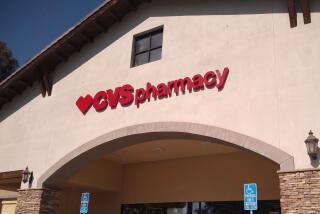Column: Gilead harmed patients by overpricing its drugs. But did it miscalculate?
- Share via
Gilead Sciences, the maker of two stratospherically high-priced drugs for hepatitis C patients, says it cares deeply about enabling patient access to the drugs and “enabling healthcare accessible for all Americans.”
According to a new report from the Senate Finance Committee, here’s how it showed its concern:
--Its executives concluded it could make a profit by charging $55,000 per 12-week treatment for Sovaldi, its original breakthrough drug. But the company decided to charge $84,000, which would deliver higher profits from fewer patients. A follow-on drug known as Harvoni, which incorporates Sovaldi, was introduced last year at a price close to $100,000 for a full treatment.
--The Foster City company refused to offer anything but minimal discounts to big insurers and Medicaid programs, even though they acknowledged that thousands of patients might have to go without the treatments.
--The company braced for--and scorned--a public backlash over its pricing, but figured even complaints from patient advocates wouldn’t lead to problems with regulators or legislators. “Let’s not fold to advocacy pressure…whatever the headlines,” one top executive counseled his colleagues.
What we face is not a drug cost problem; it is a drug price problem.
— Lynne Saxton, head of Oregon’s Medicaid program
“It was always Gilead’s plan to maximize revenue, and affordability and accessibility was an afterthought,” said Sen. Ron Wyden, D-Oregon, who co-produced the report with Committee Chairman Chuck Grassley, R-Iowa.
While the company expected that “key opinion leaders” would be “vocal about their concerns” at a price over $80,000, it assumed there would be no change in public or insurance industry policies that might cut into its earnings.
The report adds important details to what we know about Gilead’s strategy and opens a window into drug industry practices generally. We earlier reported on the scandal of Sovaldi and Harvoni pricing here and here.
The report finds that while the company expected “key opinion leaders” would be “vocal about their concerns” at a price over $80,000, it assumed there would be no change in public or insurance industry policies that might cut into its earnings.
As it turns out, Gilead was wrong. Major insurers balked, approving the drugs only for patients with the most severe manifestations of hepatitis C. Public outrage turned drug pricing into a political issue, generating investigations like Wyden’s and Grassley’s.
Whether this will result in legislative changes remains uncertain, so Gilead and its fellow drug companies may yet remain the victors. Indeed, the committee report makes no specific legislative recommendations, a major flaw. But there’s no question that the reaction was more severe than Gilead anticipated.
“We respectfully disagree with the conclusions” of the Senate report, Gilead said in a statement. The company said it “responsibly and thoughtfully priced Sovaldi and Harvoni,” and that given the drugs’ high cure rates and low side effects, the cost of treatment is lower than it was before the drugs appeared on the market.
Grassley and Wyden say, however, that Gilead’s price decision had little to do with such traditional considerations as the cost of development or manufacture, and more to do with market power. One executive involved in setting the price of Sovaldi didn’t even know what it cost to manufacture the pills when he was interviewed by committee staff, according to the report.
Let’s take a look at how Gilead settled on its price for Sovaldi and Harvoni.
Gilead acquired Sovaldi’s developer, Pharmasset, for $11 billion in 2011, at a time when its own efforts on hepatitis C were faltering. The acquisition was not popular on Wall Street, which sharply bid down Gilead shares. One securities analyst estimated that drug sales would have to reach $4 billion a year to justify the acquisition. As it turned out, in 2014, the first year Gilead sold both Sovaldi and Harvoni, they brought in $12.4 billion.
Pharmasset had spent about $62.4 million to develop Sovaldi, including a federal grant of $245,000. It was prepared to market Sovaldi at $36,000 for a 12-week cure. Gilead thought it could turn a profit on the drug at $55,000. Its executives also thought that a price over $80,000 would produce a public outcry, but not coverage restrictions from insurers. In part, this is because Sovaldi genuinely is a miracle drug — highly effective at curing hepatitis C, virtually without serious side effects.
The company assumed that fewer patients would be served as the price point rose but that overall revenue would keep rising until the price reached about $96,000. Another consideration was that the price for Sovaldi would create a baseline for the next drug, Harvoni, a superior formulation — so pricing Sovaldi too low would affect Gilead’s potential revenues for years. Gilead had some concerns about competition from a forthcoming rival drug known as Viekira Pak, but assumed that its manufacturer, AbbVie, would also price it high.
As the drugs reached the market, Gilead backed them with aggressive promotion. It paid about $5 million in fees to doctors and other professionals in 2014 for speeches hawking its drugs, providing the speakers with slides and handouts that they were not to depart from. Harvoni was advertised heavily on television. Insurers seeking rebates or discounts for their enrollees often were rebuffed. Giant Kaiser Permanente sought rebates as high as 49%; it got 20%.
Some of the Senate’s most important points concern the impact of Gilead’s pricing on public healthcare programs such as Medicare and Medicaid. Sovaldi came to rank as the top drug-spending item for 14 state Medicaid agencies, the second biggest item for 15 more and among the top five for 33 states.
The impact on state budgets can be devastating; many were forced effectively to ration the drugs, offering them only to the sickest patients. But their options are limited because Medicaid rules require them to provide access to any FDA-approved drugs. “What we face is not a drug cost problem,” Lynne Saxton, the head of Oregon’s Medicaid program, told the Senate committee, “it is a drug price problem.”
What should be done about all this? The Senate Committee is silent, although plenty of ideas have circulated for years: Allow Medicare to negotiate prices with drug companies; allow U.S. patients to buy drugs abroad, especially from Canada, where prices are cheaper; mandate more openness in drug pricing.
“The public may be surprised to learn that members of Congress are forbidden by law to have access to information regarding price discounts and rebates agreed to by drug manufacturers as part of the Medicare and Medicaid programs,” the report states.
Yes, we’re surprised. Who benefits from that blindfold, except the drug companies? The Senate could strike a first blow for rational drug pricing by taking the blinder off and collecting information that lawmakers and the public direly need.
Keep up to date with Michael Hiltzik. Follow @hiltzikm on Twitter, see our Facebook page, or email [email protected].
More to Read
Inside the business of entertainment
The Wide Shot brings you news, analysis and insights on everything from streaming wars to production — and what it all means for the future.
You may occasionally receive promotional content from the Los Angeles Times.











